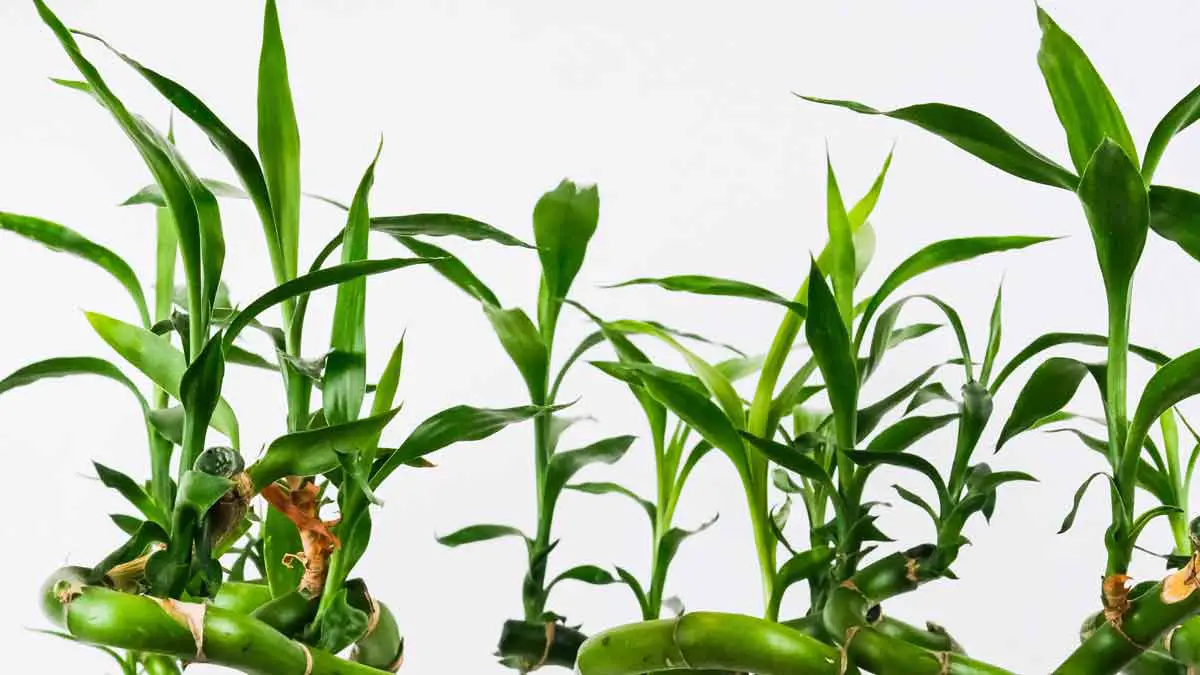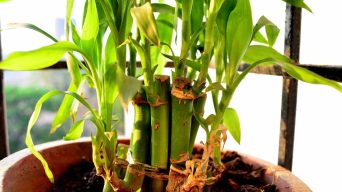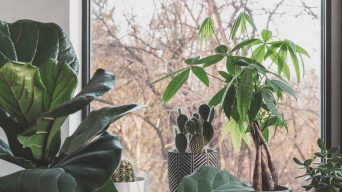To make lucky bamboo grow faster, provide bright indirect light, regular watering with filtered water, occasional fertilization, and proper pruning. Maintain ideal temperature and humidity, use well-draining soil, repot as needed, prevent pests, and address diseases promptly. In water, use filtered water, change it regularly, prune, and rotate the plant for even growth.
Dracaena sanderiana, or lucky bamboo, is a popular plant due to its ability to thrive indoors with little care.
The lucky bamboo plant is known for its resilient nature and ability to grow quickly.
However, you can do a few things to help your lucky bamboo grow even faster.
This article will provide tips on making lucky bamboo grow faster to create an even more abundant indoor garden.
How To Make Your Lucky Bamboo Grow Faster
The secret to making your lucky bamboo grow faster is to provide it with the ideal growing conditions.
Here are some tips on how to do just that:
1. Provide Bright, Indirect Light
Lucky bamboo is a type of plant that thrives in moderate to bright indirect light.
However, this indoor plant can grow faster and healthier when you provide it with bright indirect light, such as from a nearby east- or west-facing window.
The key to providing bright indirect light for your lucky bamboo is to ensure you are not exposing it to direct sunlight. This can be done by placing your lucky bamboo near a sheer curtain or blinds, using reflective materials, or using other creative solutions you discover.
2. Water Your Lucky Bamboo Regularly
Lucky bamboo grows best in moist soil, so it is essential to water your plant regularly.
The best way to water your lucky bamboo is to use distilled or filtered water to avoid any mineral build-up in the soil.
You should also allow the top layer of the soil to dry out before watering your plant again. This will help to ensure that your lucky bamboo is not overwatered, which can lead to problems such as root rot.
Lucky bamboo plants need to be watered about once a week or when the top layer of soil begins to dry.
Be sure to empty any excess water from the saucer or tray after watering so your plant is not sitting in water.
3. Fertilize Your Lucky Bamboo Plant
To keep your lucky bamboo plant growing strong and healthy, it is essential to fertilize it regularly.
You can use a liquid fertilizer that is designed explicitly for houseplants, or you can use a slow-release fertilizer pellet.
Fertilize your lucky bamboo about once a month during the growing season (spring and summer) and every other month during the fall and winter.
Use a small amount of fertilizer, as overfertilization can damage your plant.
4. Prune Your Lucky Bamboo Plant
The lucky bamboo plant flourishes indoors and outdoors and requires little pruning or care to grow quickly and healthily.
However, for lucky bamboo to reach its full potential, it must be pruned regularly.
By trimming the leaves at the top of the stalk and regularly removing dead or dying roots, you ensure that your lucky bamboo has all the resources it needs to thrive.
Not only does this help keep your plant looking healthy and lush, but it also encourages faster growth that you can enjoy watching over time.
So if you want your lucky bamboo to grow faster and efficiently, remember to invest some time in regular pruning!
5. Provide the Right Temperature
Lucky bamboo plants are native to tropical regions, and as such, they prefer warm temperatures.
The ideal temperature range for lucky bamboo is between 65 and 90 degrees Fahrenheit.
If you live in a region with a colder climate, you can still grow lucky bamboo successfully by keeping your plant in a pot and placing it on a heating mat.
Avoid putting your lucky bamboo in direct sunlight, which can cause the leaves to scorch.
6. Provide Adequate Humidity
Lucky bamboo plants thrive in humid environments.
The ideal humidity level for lucky bamboo is between 50 and 60 percent.
If the air in your home is too dry, you can increase the humidity around your plant by placing it on a pebble tray filled with water or using a humidifier.
A pebble tray is a shallow tray filled with gravel, rocks, and water. The water evaporates and increases the humidity around the plant.
When using a humidifier, please keep it away from the lucky bamboo plant, so the mist does not damage the leaves.
7. Use the Right Soil
Lucky bamboo grows best in potting soil that is nutrient-rich and well-drained.
The best way to achieve this is to mix equal parts peat moss, perlite, and sand.
You can also use a commercial potting mix for lucky bamboo or other houseplants.
Be sure to avoid using too dense or clay-like soil, as this can lead to problems with drainage.
Choosing the right type of soil for your lucky bamboo is essential because the roots are very sensitive and can easily be damaged.
8. Repot Your Lucky Bamboo Plant Regularly
Lucky bamboo plants grow quickly and will need to be repotted regularly.
The frequency with which you must repot your plant will depend on how fast it grows.
A good rule of thumb is to repot your lucky bamboo plant every one to two years.
When repotting, be sure to use a pot that is only slightly larger than the current one.
This will help to prevent your plant from becoming rootbound.
It’s essential to repot your lucky bamboo regularly because the roots are very sensitive and can easily be damaged.
By repotting regularly, you also ensure that your plant has access to fresh soil and nutrients.
9. Keep Your Lucky Bamboo Free From Pests
Lucky bamboo plants are susceptible to infestations from mealybugs, aphids, and other pests.
Inspect your plant regularly for signs of infestation to keep it free from pests.
If you find pests on your lucky bamboo, you can remove them by hand using a cotton swab dipped in isopropyl alcohol.
You can also treat your plant with an insecticide soap or neem oil. These products are safe to use on lucky bamboo and will not harm the plant.
Be sure to follow the instructions on the product label carefully when using any pesticide on your lucky bamboo plant.
10. Keep Your Lucky Bamboo Plant Healthy and Free From Diseases
Lucky bamboo is a hardy plant but can still be susceptible to diseases.
The most common disease that affects lucky bamboo is root rot.
This disease is caused by too much moisture around the plant’s roots.
To prevent root rot, ensure adequate drainage for your plant and never allow the roots to sit in water.
If your plant shows signs of root rot, you can save it by removing the affected roots and repotting the plant in fresh soil.
Another disease that can affect lucky bamboo is leaf spot. This disease is caused by a fungus and appears as small, dark spots on the plant’s leaves.
To prevent leaf spot, ensure adequate ventilation for your plant and remove any affected leaves as soon as you notice them.
You can also treat your plant with a fungicide to help prevent the disease from spreading.
How To Make Lucky Bamboo Grow Faster in Water
Growing lucky bamboo in water is easy, and with a few tips, you can have your plant thriving in no time.
Here are ten tips on how to make lucky bamboo grow faster in water:
- Use filtered or distilled water. This will help to prevent the build-up of minerals that can impede growth.
- Change the water regularly. Lucky bamboo likes fresh water, so change it every week or two.
- Cut off any yellow or brown leaves. These are dying leaves and need to be removed for the plant to focus its energy on healthy growth.
- Place lucky bamboo in a bright, indirect light. Too much direct sunlight can scorch the leaves, but too little light will cause the plant to become leggy and weak.
- Keep lucky bamboo away from drafts. These can cause the plant to become stressed and impede growth.
- Fertilize lucky bamboo monthly with a water-soluble fertilizer. Be sure to follow the directions on the package.
- Prune lucky bamboo to encourage fuller growth. Cut off any shoots that are longer than you want, and they will branch out and become bushier.
- Change the position of your lucky bamboo. Rotating it every few weeks will help it to grow evenly.
- Check the roots regularly. If they are becoming too large for the pot, you will need to transplant them into a larger container.
These tips will help you to grow healthy, fast-growing lucky bamboo in water. With some care, your plant will thrive and bring you good luck for years.
Final Thoughts
The Dracaena sanderiana is a beautiful and popular plant that is easy to care for. Though it is not bamboo, this plant can grow rapidly if the right conditions are met.
Lucky bamboo care is not complex, but there are a few things to keep in mind to ensure your plant thrives.
Following the tips above, you can ensure your lucky bamboo grows faster and remains healthy for years.







